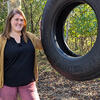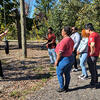These resources are designed to highlight fun, hands-on outdoor experiences that you can engage with at home or in other outdoor spaces. By reading and watching these resources we hope that it inspires you to get outside and explore nature safely and with more curiosity and interest!

Holly Lynn: Connecting People with the Outdoors and Each Other
According to Holly Lynn, one of her primary goals as Temple Ambler’s new Manager of Experiential Learning, is ensuring that outdoor experiential initiatives are accessible for everyone, "meeting people where they are and ensuring that whatever goals they might have when investing their time in these experiences is worthwhile and meaningful."
"There is a great deal of value in the healing aspects of being outdoors, the reinvigorating and rejuvenating feelings that being in a natural setting gives us, especially for individuals who may not typically or as easily have access to those spaces," she said. Read more.
Learn about Outdoor Experiential Learning at Temple Ambler

Unique Learning Experiences for the Temple Community and Beyond
Moving a ball from one peg built to keep it about a foot off the ground to its twin sitting across a field or classroom. Sounds pretty simple, right?
Then add in a metal ring to balance the ball on, several pieces of string to lift it up and about eight or 10 students, faculty members or staff all with their own strategies and plans to get from Point A to Point B. Then you have a challenge, one of several teambuilding, communication and problem-solving exercises offered by Recreation, Outdoor Education & Wellness at Temple University Ambler.
Since designing and constructing a Low Ropes Challenge Course at Temple Ambler in summer and fall 2022, Recreation, Outdoor Education & Wellness has offered teambuilding and outdoor experiential learning opportunities for Temple University students, faculty, staff, alumni and community organizations utilizing community building activities, team initiatives and the Ambler Campus Low Ropes Challenge Course. Learn more.

Ready for the Challenge
The state-of-the-art Temple Ambler challenge course facility features a total of 15 permanent elements. Student organizations, classroom teams, research interns and more are able to explore the teambuilding opportunities offered through the challenge course. Programs for the course are conducted in 2 to 4- or 5 to 8-hour experiences and highlight problem-solving, conflict resolution and foster trust within a group or team.
Those interested in booking a program or retreat may reach out to Holly Lynn, Manager of Experiential Learning, at [click-for-email] or 267-468-8107. Learn more.

Students Become the Facilitators
At Temple Ambler, Temple University students have the opportunity to become Experiential Education Facilitators.
Facilitators are responsible for delivering programming utilizing the community building activities, team initiatives and the low ropes challenge course as well as debriefing strategies.
With these experiential programs, Lynn said, “debrief is essential to get the most out of it — you have to ask the questions that lead participants to reflect on ‘what happened, so what and now what.’” Learn more.

What better way to enjoy the seasons than being outdoors? In this video, Dr. Steve Sassaman, former Assistant Director of Recreation, Outdoor Education & Wellness at Temple Ambler, walks you through the steps of setting up a tent! Sleeping out under the stars can be quite an experience but depending on conditions you may want a solid shelter to protect you from bugs and the elements. There are many options when it comes to tents that serve this purpose. This video will provide an overview of how to set up a tent using basic principles and practices that can be applied to any model you may find yourself sleeping in.
Stakes 101
This is a particularly high stakes video — it’s all about stakes! Dr. Sassaman, former Assistant Director of Recreation, Outdoor Education & Wellness, continues his key steps for setting up a tent. An important consideration in ensuring that your tent is set up securely is taking time to stake out your tent properly. This can include choosing to upgrade your stakes to meet varying ground conditions. By taking time to identify a suitable area and driving the stake in precisely at a 45-degree angle one can ensure a secure and comfortable set up.
Packing Up Your Tent
For the final part of our tent trilogy, it’s time to pack up and hit the trail. Dr. Sassaman, former Assistant Director of Recreation, Outdoor Education & Wellness, continues his key steps for tent success! Maybe you’re on a multi-day expedition in nasty weather conditions, or you may simply want to create some solid habits while cleaning up your campsite after a great evening outdoors. Taking time to protect your tent as you pack it up will ensure that you prolong the life of your gear as well as help you set up your tent efficiently when you make it to the next destination. Remember when you get home from your adventure to unpack your tent so that it can dry out before storing long term. We recommend storing your tent in a large mesh laundry bag rather than the stuff sack you use to carry on the trail.
The Rule of Three
Dr. Sassaman, former Assistant Director of Recreation, Outdoor Education & Wellness, provides an easy way to remember our survival priorities using the “Rule of Three.” The average human can survive three minutes without air, three hours without protection from the elements, three days without water, and three weeks without food. Even for a short day hike, you want to ensure you are prepared with water to stay hydrated and layers to stay protected from the elements!
Layering
Dr. Sassaman, former Assistant Director of Recreation, Outdoor Education & Wellness, shares a broad overview of the importance of layering during outdoor activities. He discusses the advantages and disadvantages of different materials and effective strategies for regulating your body temperature while participating in outdoor activities.
The 10 Essentials
Dr. Sassaman, former Assistant Director of Recreation, Outdoor Education & Wellness, discusses the importance of being prepared with your ten essentials for any outdoor activity, including short day hikes. The ten essentials include: positive mindset and plan; navigation; light source (headlamp); first aid; shelter; knife; fire-starting equipment; extra food and water purification; additional clothing for changing weather conditions; and signaling device/emergency communication.
Learn About Ephemeral Pools With the Temple Ambler Field Station
In this video, Mary Cortese, former Research Assistant with the Temple Ambler Field Station, explores ephemeral, or vernal, pools and their place in the ecosystem of the Temple Forest Observatory. A vernal, or ephemeral, pool is a seasonal body of water similar to a small pond that fills with rain every season.
Backyard Scavenger Hunt: Making Plant Discoveries
What are all of those plants in your yard and in your neighborhood? Can you tell a woody plant from an herbaceous plant; a monocot from a dicot; a compound leaf from a simple leaf? How about a single flower versus an inflorescence? Join Ben Snyder, Manager of the Tyler School of Art and Architecture Greenhouse Education and Research Complex at Temple Ambler, as he guides you on a scavenger hunt of discovery. Ben will provide information on the different types of plants and tips on identifying plans that you can find right in your own environment. How many can you identify?
Leave No Trace
Before we go anywhere, we need to learn about “Leave No Trace.” When camping, hiking or simply enjoying the outdoors, it is essential to leave any place you have visited as you found it. In this video, Mary Cortese, former Research Assistant with the Temple Ambler Field Station and PhD Candidate in the Temple University Biology Department, provides an overview of the “Seven Tips for Leave No Trace” from the Center for Outdoor Ethics.
Day Hiking 101: Packing a Backpack
You are ready to head out for a day of hiking! Do you know what you should take along with you? How should you carry it? Where should you store it? Join avid hiker Mary Cortese, former Research Assistant with the Temple Ambler Field Station, as she shares her essentials for a successful day hike!
Exploring and Protecting Creeks and Streams
We’re heading out into Temple University Ambler’s 187 acres to explore creeks and steams on campus with Mary Cortese, former Research Assistant with the Temple Ambler Field Station! Mary will talk about why these streams are important and how you can do your part to protect them!

